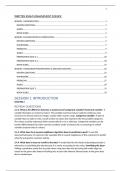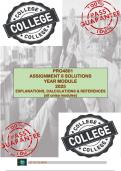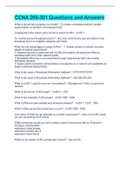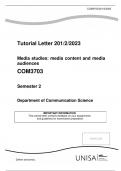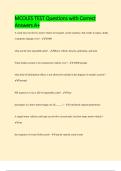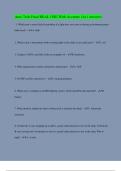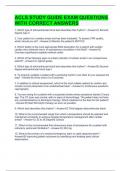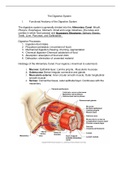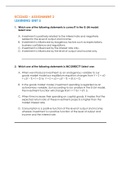ECS2605 – AUGUST 2017
SUMMARIZED NOTES
CONTENTS
1 LEARNING UNIT 1: ............................................................................................ 3
2 LEARNING UNIT 2: THE ROLE OF BANKS IN THE FINANCIAL SYSTEM ..... 3
2.1 How Banks Create Money............................................................................. 3
2.2 The Role of Banks and their Income ............................................................. 5
2.3 The Mismatch between the Assets and Liabilities of Banks .......................... 7
2.4 Regulation of Banks ...................................................................................... 8
2.5 The Significance of the banking industry in south africa ............................... 9
2.6 The role of the South African Reserve Bank ................................................. 9
3 LEARNING UNIT 3: THE ROLE OF OTHER FINANCIAL INSTITUTIONS IN THE
SOUTH AFRICAN FINANCIAL SYSTEM................................................................ 15
3.1 The Financial Services Board ..................................................................... 15
3.2 Insurers ....................................................................................................... 17
3.3 Retirement Funds........................................................................................ 21
3.4 Investment Institutions ................................................................................ 26
3.5 Microfinance Institutions (MFIs) .................................................................. 32
3.6 Banks – Microfinance Institutions ................................................................ 35
3.7 Other Microfinance Institutions .................................................................... 36
4 LEARNING UNIT 4: THE DECISION MAKING PROCESS IN THE FINANCIAL
MARKETS ............................................................................................................... 38
4.1 basic Terminilogy and Calculations ............................................................. 38
4.2 Meaning of Symbols in Formulas ................................................................ 43
4.3 Discount Instruments .................................................................................. 43
4.4 Interest Add-on Instruments ........................................................................ 45
4.5 Repurchase agreements ............................................................................. 46
4.6 Bond Instrument .......................................................................................... 47
4.7 Factors that Affect the Interest rate on Bonds ............................................. 51
5 OVERVIEW OF FINANCIAL MARKETS AND INSTRUMENTS ....................... 53
5.1 tHE mONEY mARKET ................................................................................ 53
,
,1 LEARNING UNIT 1:
2 LEARNING UNIT 2: THE ROLE OF BANKS IN THE FINANCIAL SYSTEM
2.1 HOW BANKS CREATE MONEY
Money – anything that is generally accepted as a means of payment.
Money has two components held by the local non-bank private sector (NBPS):
C – notes and coins
D – Bank deposits
Basic formula for amount of money in circulation: M = C + D of the NBPS
Quantity theory of money: M + V = P + RGDP
M – money
V – velocity of circulation of M
P – price level
RGDP – GDP in real terms (after adjusting for P) (P x RGDP = nominal GDP)
An increase in RGDP cannot take place without an increase in M and if M growth is
higher than the economy’s ability to adjust to the increased demand underlying the
change in M, inflation results and growth suffers.
Money creation
Example when banks provide a credit:
Company B borrows R10 million from a bank through the issue of R10 million in bonds
with the objective of purchasing R10 million in goods from Company C.
The bank credits Company B’s current account with R10 million and Company B pays
Company C R10 million by EFT. Company C then becomes a surplus economic unit
due to the new bank deposit while Company B becomes a deficit economic unit due
to the loan it holds with the bank.
From the above, the bank sector has a new asset of R10 million from the bond of
Company B and a new deposit liability of R10 million from the deposit of Company C.
Therefore M has increased by R10 million and the balance sheet cause of changes
(BSCoC) in M is the loan by the bank.
, Monetary policy
The process in which the size and rate of growth of the money supply is determined
which in turn affects interest rates and achieves price stability.
The central bank implements monetary policy by creating a permanent liquidity
shortage. It forces the bank via open market operations (OMO) to borrow from it on an
overnight but permanent basis an amount of money called Borrowed Reserves (BR)
at the repo rate.
The narrow definition of money is M1:
M1 = C + D
M1 consists of currency and current account deposits in the hands of the private non-
bank sector held with monetary institutions.
Currency is another terms for bank notes and coins. Current account deposits also
referred to as demand deposits and include cheque accounts.
Who supplies deposits (D) and what determines the amount supplied?
The bank supplies deposits and the supply of bank deposits is proximately determined
by those banks that can create current accounts however such banks cannot create
however many new accounts at will.
The supply is constrained in part by central bank regulations pertaining to reserve
requirements and capital adequacy requirements.
Till money and required reserve deposits at the central bank does not form part of
money supply.
Cheque – represents an instruction to a bank to transfer funds from one person’s
account to another’s where the two persons do not necessarily bank at the same bank.
A cheque is not money because it is simply the means or set of instructions whereby
funds are transferred. It is in effect a payment instrument.
Reserve ratio (𝛼𝛼) – the percentage of current account deposits required by the Central
Bank that the banks have to hold in the form of reserve deposits with the central bank.
If 𝛼𝛼 = 0.2 and the bank has current account deposits of R100 000. It has to keep
R100 000 x 0.2 = R20 000 in reserve.
In addition to reserve requirements with the central bank, banks have to keep reserves
in the form of notes and coins in their vaults and ATMs to satisfy the public’s demand
for currency.
Read page 64 for example of how banks create money by extending loans and
creating deposits.
Sum of the reserve ratio calculation:
SUMMARIZED NOTES
CONTENTS
1 LEARNING UNIT 1: ............................................................................................ 3
2 LEARNING UNIT 2: THE ROLE OF BANKS IN THE FINANCIAL SYSTEM ..... 3
2.1 How Banks Create Money............................................................................. 3
2.2 The Role of Banks and their Income ............................................................. 5
2.3 The Mismatch between the Assets and Liabilities of Banks .......................... 7
2.4 Regulation of Banks ...................................................................................... 8
2.5 The Significance of the banking industry in south africa ............................... 9
2.6 The role of the South African Reserve Bank ................................................. 9
3 LEARNING UNIT 3: THE ROLE OF OTHER FINANCIAL INSTITUTIONS IN THE
SOUTH AFRICAN FINANCIAL SYSTEM................................................................ 15
3.1 The Financial Services Board ..................................................................... 15
3.2 Insurers ....................................................................................................... 17
3.3 Retirement Funds........................................................................................ 21
3.4 Investment Institutions ................................................................................ 26
3.5 Microfinance Institutions (MFIs) .................................................................. 32
3.6 Banks – Microfinance Institutions ................................................................ 35
3.7 Other Microfinance Institutions .................................................................... 36
4 LEARNING UNIT 4: THE DECISION MAKING PROCESS IN THE FINANCIAL
MARKETS ............................................................................................................... 38
4.1 basic Terminilogy and Calculations ............................................................. 38
4.2 Meaning of Symbols in Formulas ................................................................ 43
4.3 Discount Instruments .................................................................................. 43
4.4 Interest Add-on Instruments ........................................................................ 45
4.5 Repurchase agreements ............................................................................. 46
4.6 Bond Instrument .......................................................................................... 47
4.7 Factors that Affect the Interest rate on Bonds ............................................. 51
5 OVERVIEW OF FINANCIAL MARKETS AND INSTRUMENTS ....................... 53
5.1 tHE mONEY mARKET ................................................................................ 53
,
,1 LEARNING UNIT 1:
2 LEARNING UNIT 2: THE ROLE OF BANKS IN THE FINANCIAL SYSTEM
2.1 HOW BANKS CREATE MONEY
Money – anything that is generally accepted as a means of payment.
Money has two components held by the local non-bank private sector (NBPS):
C – notes and coins
D – Bank deposits
Basic formula for amount of money in circulation: M = C + D of the NBPS
Quantity theory of money: M + V = P + RGDP
M – money
V – velocity of circulation of M
P – price level
RGDP – GDP in real terms (after adjusting for P) (P x RGDP = nominal GDP)
An increase in RGDP cannot take place without an increase in M and if M growth is
higher than the economy’s ability to adjust to the increased demand underlying the
change in M, inflation results and growth suffers.
Money creation
Example when banks provide a credit:
Company B borrows R10 million from a bank through the issue of R10 million in bonds
with the objective of purchasing R10 million in goods from Company C.
The bank credits Company B’s current account with R10 million and Company B pays
Company C R10 million by EFT. Company C then becomes a surplus economic unit
due to the new bank deposit while Company B becomes a deficit economic unit due
to the loan it holds with the bank.
From the above, the bank sector has a new asset of R10 million from the bond of
Company B and a new deposit liability of R10 million from the deposit of Company C.
Therefore M has increased by R10 million and the balance sheet cause of changes
(BSCoC) in M is the loan by the bank.
, Monetary policy
The process in which the size and rate of growth of the money supply is determined
which in turn affects interest rates and achieves price stability.
The central bank implements monetary policy by creating a permanent liquidity
shortage. It forces the bank via open market operations (OMO) to borrow from it on an
overnight but permanent basis an amount of money called Borrowed Reserves (BR)
at the repo rate.
The narrow definition of money is M1:
M1 = C + D
M1 consists of currency and current account deposits in the hands of the private non-
bank sector held with monetary institutions.
Currency is another terms for bank notes and coins. Current account deposits also
referred to as demand deposits and include cheque accounts.
Who supplies deposits (D) and what determines the amount supplied?
The bank supplies deposits and the supply of bank deposits is proximately determined
by those banks that can create current accounts however such banks cannot create
however many new accounts at will.
The supply is constrained in part by central bank regulations pertaining to reserve
requirements and capital adequacy requirements.
Till money and required reserve deposits at the central bank does not form part of
money supply.
Cheque – represents an instruction to a bank to transfer funds from one person’s
account to another’s where the two persons do not necessarily bank at the same bank.
A cheque is not money because it is simply the means or set of instructions whereby
funds are transferred. It is in effect a payment instrument.
Reserve ratio (𝛼𝛼) – the percentage of current account deposits required by the Central
Bank that the banks have to hold in the form of reserve deposits with the central bank.
If 𝛼𝛼 = 0.2 and the bank has current account deposits of R100 000. It has to keep
R100 000 x 0.2 = R20 000 in reserve.
In addition to reserve requirements with the central bank, banks have to keep reserves
in the form of notes and coins in their vaults and ATMs to satisfy the public’s demand
for currency.
Read page 64 for example of how banks create money by extending loans and
creating deposits.
Sum of the reserve ratio calculation:


